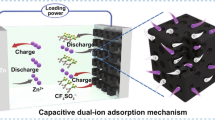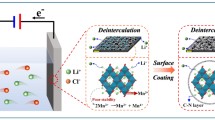Abstract
With the continuous development of global industry and the increasing demand for lithium resources, recycling valuable lithium from industrial solid waste is necessary for sustainable development and environmental friendliness. Herein, we employed ion imprinting and capacitive deionization to prepare a new electrode material for lithium-ion selective recovery. The material morphology and structure were characterized using scanning electron microscopy, Fourier-transform infrared spectroscopy, and other characterization methods, and the adsorption mechanism and water clusters were correlated using the density functional theory. The electrode material exhibited a maximum adsorption capacity of 36.94 mg/g at a Li+ concentration of 600 mg/L. The selective separation factors for Na+, K+, Mg2+, and Al3+ in complex solution environments were 2.07, 9.82, 1.80, and 8.45, respectively. After undergoing five regeneration cycles, the material retained 91.81% of the initial Li+ adsorption capacity. Meanwhile, the electrochemical adsorption capacity for Li+ was more than twice the corresponding conventional physical adsorption capacity because electrochemical adsorption provides the energy needed for deprotonation, enabling exposure of the cavities of the crown ether molecules to enrich the active sites. The proposed environment-friendly separation approach offers excellent selectivity for Li+ recovery and addresses the growing demand for Li+ resources.








Similar content being viewed by others
References
Anand B, Kumar V, Younis SA, Kim K-H (2022) HKUST-1 infused woven cotton filter for enhanced adsorptive removal of toluene vapor from gaseous streams. Sep Purif Technol 299:121743. https://doi.org/10.1016/j.seppur.2022.121743
Bai X, Dai J, Ma Y et al (2020) 2-(Allyloxy) methylol-12-crown-4 ether functionalized polymer brushes from porous PolyHIPE using UV-initiated surface polymerization for recognition and recovery of lithium. Chem Eng J 380:122386–122386. https://doi.org/10.1016/j.cej.2019.122386
Battistel A, Palagonia MS, Brogioli D et al (2020) Electrochemical methods for lithium recovery: a comprehensive and critical review. Adv Mater 32:1905440. https://doi.org/10.1002/adma.201905440
Baudino L, Santos C, Pirri CF et al (2022) Recent advances in the lithium recovery from water resources: from passive to electrochemical methods. Adv Sci 9:2201380. https://doi.org/10.1002/advs.202201380
Bruce PG, Freunberger SA, Hardwick LJ, Tarascon J-M (2011) Li–O2 and Li–S batteries with high energy storage. Nat Mater 11:19–29. https://doi.org/10.1038/nmat3191
Cui J, Zhou Z, Liu S et al (2018) Synthesis of cauliflower-like ion imprinted polymers for selective adsorption and separation of lithium ion. Chem 42:14502–14509. https://doi.org/10.1039/c8nj03249a
De S, Sk. Musharaf Ali, M.R.K. Shenoi, et al (2009) Conformational effect on the preferential binding of alkali metal cation with crown ether: a molecular level investigation. Desalin Water Treat 12:93–99. https://doi.org/10.5004/dwt.2009.947
E. Suss M, Porada S, Sun X et al (2015) Water desalination via capacitive deionization: what is it and what can we expect from it? Energy Environ Sci 8:2296–2319. https://doi.org/10.1039/C5EE00519A
Farmer JC, Fix DV, Mack GV et al (1996) Capacitive deionization of NaCl and NaNO3 solutions with carbon aerogel electrodes. J Electrochem Soc 143:159–169. https://doi.org/10.1149/1.1836402
Gruber P, Medina P, Keoleian G et al (2011) Global lithium availability a constraint for electric vehicles? J Ind Ecol 15 https://doi.org/10.1111/j.1530-9290.2011.00359.x
Han N, Gao R, Peng H et al (2022) Selective recovery of lithium ions from acidic medium based on capacitive deionization-enhanced imprinted polymers. J Clean Prod 373:133773–133773. https://doi.org/10.1016/j.jclepro.2022.133773
Hou J, Zhang H, Thornton AW et al (2021) Lithium extraction by emerging metal–organic framework-based membranes. Adv Func Mater 31:2105991. https://doi.org/10.1002/adfm.202105991
Huang Y, Wang R (2019) Green recovery of lithium from water by a smart imprinted adsorbent with photo-controlled and selective properties. Chem Eng J 378:122084. https://doi.org/10.1016/j.cej.2019.122084
Huang Y, Wang R (2018) An efficient lithium ion imprinted adsorbent using multi-wall carbon nanotubes as support to recover lithium from water. J Clean Prod 205:201–209. https://doi.org/10.1016/j.jclepro.2018.09.076
Jin W, Zhang Y (2020) Sustainable electrochemical extraction of metal resources from waste streams: from removal to recovery. ACS Sustain Chem Eng 8:4693–4707. https://doi.org/10.1021/acssuschemeng.9b07007
Kim J, Oh S, Kwak S-Y (2015) Magnetically separable magnetite–lithium manganese oxide nanocomposites as reusable lithium adsorbents in aqueous lithium resources. Chem Eng J 281:541–548. https://doi.org/10.1016/j.cej.2015.06.090
Lee Y, Cha J, Jung D (2021) Selective lithium adsorption of silicon oxide coated lithium aluminum layered double hydroxide nanocrystals and their regeneration. Chem Asian J 16:974–980. https://doi.org/10.1002/asia.202100126
Liu H, Zhou Y, Zhu F et al (2020a) Micro hydration structure of aqueous Li+ by DFT and CPMD. Eur Phys J D 74. https://doi.org/10.1140/epjd/e2019-100233-2
Liu W, Yan G, Zhang E et al (2020b) Extraction of lithium ions from acidic solution using electrochemically imprinted membrane. Desalination 496:114751–114751. https://doi.org/10.1016/j.desal.2020.114751
Luo X, Guo B, Luo J et al (2015) Recovery of lithium from wastewater using development of Li ion-imprinted polymers. ACS Sustain Chem Eng 3:460–467. https://doi.org/10.1021/sc500659h
Luo X, Zhang K, Luo J et al (2016) Capturing lithium from wastewater using a fixed bed packed with 3-D MnO2 ion cages. Environ Sci Technol 50:13002–13012. https://doi.org/10.1021/acs.est.6b02247
Markham GD, Glusker JP, Bock CL et al (1996) Hydration energies of divalent beryllium and magnesium ions: an ab initio molecular orbital study. J Phys Chem 100:3488–3497. https://doi.org/10.1021/jp952531t
McOwen DW, Xu S, Gong Y et al (2018) 3D-printing electrolytes for solid-state batteries. Adv Mater 30:1707132. https://doi.org/10.1002/adma.201707132
Qin M, Deshmukh A, Epsztein R et al (2019) Comparison of energy consumption in desalination by capacitive deionization and reverse osmosis. Desalination 455:100–114. https://doi.org/10.1016/j.desal.2019.01.003
Roskill (2021) BU-308: Availability of lithium. In: Battery University. https://batteryuniversity.com/article/bu-308-availability-of-lithium. Accessed 23 Aug 2023
Shi D, Cui B, Li L et al (2019) Lithium extraction from low-grade salt lake brine with ultrahigh Mg/Li ratio using TBP – kerosene – FeCl3 system. Sep Purif Technol 211:303–309. https://doi.org/10.1016/j.seppur.2018.09.087
Song JF, Nghiem LD, Li X-M, He T (2017) Lithium extraction from Chinese salt-lake brines: opportunities, challenges, and future outlook. Environ Sci: Water Res Technol 3:593–597. https://doi.org/10.1039/c7ew00020k
Song Y, Ye G, Lu Y et al (2016) Surface-initiated ARGET ATRP of poly(glycidyl methacrylate) from carbon nanotubes via bioinspired catechol chemistry for efficient adsorption of uranium ions. ACS Macro Lett 5:382–386. https://doi.org/10.1021/acsmacrolett.6b00099
Swain B (2017a) Recovery and recycling of lithium: a review. Sep Purif Technol 172:388–403. https://doi.org/10.1016/j.seppur.2016.08.031
Swain B (2017b) Cost effective recovery of lithium from lithium ion battery by reverse osmosis and precipitation: a perspective. J Chem Technol Biotechnol 93:311–319. https://doi.org/10.1002/jctb.5332
Tian Y, Wu J (2017) A comprehensive analysis of the BET area for nanoporous materials. AIChE J 64:286–293. https://doi.org/10.1002/aic.15880
van der Ham A, Hansen T, Lodder G et al (2019) Computational and NMR studies on the complexation of lithium ion to 8-crown-4. ChemPhysChem 20:2103–2109. https://doi.org/10.1002/cphc.201900496
Xiao J-L, Sun S, Song X et al (2015) Lithium ion recovery from brine using granulated polyacrylamide–MnO 2 ion-sieve. Chem Eng J 279:659–666. https://doi.org/10.1016/j.cej.2015.05.075
Yan Q, Li X, Wang Z et al (2012) Extraction of valuable metals from lepidolite. Hydrometallurgy 117–118:116–118. https://doi.org/10.1016/j.hydromet.2012.02.004
Yanan W, Hua L, Zhengkun W et al (2020) Progress on failure mechanism of lithium ion battery caused by diffusion induced stress. J Inorganic Mater 35:1071. https://doi.org/10.15541/jim20190622
Yang J, Qu G, Liu C et al (2022) An effective lithium ion-imprinted membrane containing 12-crown ether-4 for selective recovery of lithium. Chem Eng Res Des 184:639–650. https://doi.org/10.1016/j.cherd.2022.06.039
Zhang E, Liu W, Liang Q et al (2020a) Selective recovery of Li+ in acidic environment based on one novel electroactive Li+-imprinted graphene-based hybrid aerogel. Chem Eng J 385:123948–123948. https://doi.org/10.1016/j.cej.2019.123948
Zhang L, Li L, Rui H et al (2020b) Lithium recovery from effluent of spent lithium battery recycling process using solvent extraction. J Hazard Mater 398:122840. https://doi.org/10.1016/j.jhazmat.2020.122840
Zhu Y, Zhang G, Xu C, Wang L (2020) Interconnected graphene hollow shells for high-performance capacitive deionization. ACS Appl Mater Interfaces 12:29706–29716. https://doi.org/10.1021/acsami.0c08509
Zou X, Li M, Zhou S et al (2019) Diffusion behaviors of ethanol and water through g–C3N4–based membranes: insights from molecular dynamics simulation. J Membr Sci 585:81–89. https://doi.org/10.1016/j.memsci.2019.05.031
Funding
This research was financially supported by the National Natural Science Foundation of China (52374286, 52274279); funded by the National Key Research and Development Program of China (2021YFC2902604); funded by the Postgraduate Research & Practice Innovation Program of Jiangsu Province. (KYCX23_2831); funded by the Graduate Innovation Program of China University of Mining and Technology (2023WLJCRCZL070).
Author information
Authors and Affiliations
Contributions
Yifei Li: writing—original draft, reviewing and editing, and formal analysis. Ning Han: visualization and investigation. Qiongqiong He: methodology, resources, and writing—review and editing. Haisen Peng: formal analysis and investigation. Xiaoqi Wu: data curation and visualization. Zhen Meng: resources and visualization. Zhenyong Miao: project administration, supervision.
Corresponding author
Ethics declarations
Ethics approval
This manuscript does not contain any individual person’s data in any form (including individual details, images, or videos). There is no consent needed for this manuscript.
Consent to participate
This manuscript does not contain any individual person’s data in any form. There is no consent needed for this manuscript.
Consent for publication
All of the authors have read and approved the paper for publication.
Competing interests
The authors declare no competing interests.
Additional information
Responsible Editor: Guilherme Luiz Dotto
Publisher's Note
Springer Nature remains neutral with regard to jurisdictional claims in published maps and institutional affiliations.
Rights and permissions
Springer Nature or its licensor (e.g. a society or other partner) holds exclusive rights to this article under a publishing agreement with the author(s) or other rightsholder(s); author self-archiving of the accepted manuscript version of this article is solely governed by the terms of such publishing agreement and applicable law.
About this article
Cite this article
Li, Y., Han, N., He, Q. et al. Nitrogen-doped substrate material ion imprinting–capacitive deionization selective recovery of lithium ions from acidic solutions. Environ Sci Pollut Res 31, 27949–27960 (2024). https://doi.org/10.1007/s11356-024-32991-x
Received:
Accepted:
Published:
Issue Date:
DOI: https://doi.org/10.1007/s11356-024-32991-x




